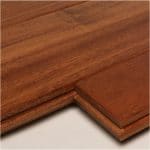HARDWOOD FLOORING 101
Hardwood flooring is manufactured from a variety of trees. In the USA, Oak flooring (red and white) are the most common species. Althoughother domestic species are growing in popularity. Other common species are, Hickory, Maple, Walnut, Ash, American Cherry, Birch and Yellow Pine. Exotic species are also available in an extremely wide variety, but the most common are, Brazilian Cherry, Cumaru, Tigerwood and Santo Mahogany.Every species brings different characteristics ranging from coloration, graining, stability (see exhibit 1) andhardness. The standard for testing hardness of hardwood is called the Janka Scale (see exhibit 2).
Trees are harvested, and logs are sawn into rough cut lumber using a variety of sawing techniques. The most common is plain sawn because it gives a greater yield than other sawing techniques. Each technique results in different appearances and also can impact the dimensional stability and overall performance of the final product.
Then the lumber is dried in a yard with sticks placed between layers to allow for better air circulation. Some mills will then move the lumber to a pre-drier which speeds up the drying process. The goal is to get the lumber down to an 18 -20% moisture content before going into the kiln. Wood to be made into hardwood flooring is then moved into a kiln where it is dried to a 6 – 8% moisture content. This is a closely measured and monitored process. It is done slowly to avoid checking and other wood drying problems. The kiln drying process also kills any insects still living in the wood. Once the lumber reachesthe desired moisture content it is milled into flooring.
Solid
Solid Wood Flooring can come in other thicknesses, but it is most commonly found in a ¾” thick platform. It is milled with a tongue and a groove so the fasteners will be hidden after installation.
Solid wood flooring is available in a variety of widths. Most common widths are 2-1/4”, 3, 3-1/4, 4, and 5”. Solid wood flooring is available in much wider widths, but anything wider than 5’ requires additional installation steps.
Solid Hardwood Flooring is more susceptible to moisture and can only be installed on or above grade.
Advantages Disadvantages
Potential greater longevity More susceptible to moisture changes
May be sanded and refinished multiple times Widths should be restricted
Potential cost advantage Species should be restricted
Installation areas are restricted
Engineered
Engineered Wood Flooring is real wood flooring that is constructed by gluing a surface veneer to a plywood core. The type of core and thickness of the product will vary from manufacturer and from product to product, but common thicknesses are 3/8”, ½”, 9/16” and ¾”.
The real key to the quality of an engineered wood floor is not the total thickness, but the thickness of the real wood wear layer. Obviously core construction is important as well, but the wear layer is the best point of comparison to a solid wood floor.
Engineered Wood Flooring may be installed in any level of a home due to the dimensional stability of the core.Another advantage of engineered flooring is it may be milled in much wider widths. Again due to the dimensional stability of the core.
Advantages Disadvantages
Available in wider and longer options May have sanding restrictions
May be installed in any level of your home Too many products
More installation options
Offers an ecological advantage
Unfinished
Unfinished Wood Flooring is also referred to as “finish in place”. It is available in both solid and engineered platforms. Unfinished flooring comes in a variety of thicknesses, widths, species, grades and cuts. After installation, the flooring is sanded several times using increasingly finer sandpaper. It is then stained (if desired) and a finish coat is applied. This process requires about 5 days to complete.
Unfinished Flooring Grades
After milling, the flooring is sorted for grade. Most flooring species are graded into one of the following categories. Although some northern species (maple and Hickory) are graded 1st Grade, 2nd Grade and Third Grade.
Clear
A flooring product of mostly heartwood with a minimum number of character marks and discoloration, providing a uniform appearance while allowing for all heartwood natural color variations. Will admit the following: 3 ⁄8” bright sapwood entire length of strip or equivalent if not extending further than 1” for 1 ⁄3 length of piece; small burls and fine pin worm holes; and equivalent characters such as small tight checks; in the absence of these, one thin brown streak 3” long to be allowed every 6’. Standard Packaging – Bundles to be 11 ⁄4’ and longer; Average length, bundled or nested, 33 ⁄4’. Shorter Packaging – Average length for 7’ and shorter packages, nested or otherwise, 31 ⁄2’.
Select & Better (not NOFMA)
Select
A flooring product with coloration variations produced by differences of natural heartwood and sapwood, along with characters described. The face may contain: unlimited sound sapwood; slight imperfections in milling; a small tight knot every 3’; pin worm holes; burls and a reasonable amount of slightly open checks. Brown streaks should not extend the entire length of a piece. Two flag worm holes to every 8’ are permitted. Slight imperfections in face work (torn grain) admitted. An intermittent, brown machine burn across the face not exceeding 1 ⁄4” width admitted. Also, a slight quantity of bark on the back or sides admitted. Will admit pieces with 1 ⁄2 tongue. Spot filling is generally required for open characters. Standard Packaging – Bundles to be 11 ⁄4’ and longer; Average length, bundled or nested, 31 ⁄4’. Shorter Packaging – Average length for 7’ and shorter packages, nested or otherwise, 3’
#1 Common
A flooring product which contains prominent variations in coloration and varying characters. The following are not admitted: broken knots over 1 ⁄2” in diameter, large grub worm holes; and splits extending through the piece. Open characters such as checks and knot holes are admitted, but must be sound and readily fillable. Not more than 20” scant stock in thickness allowed to every 5’. Minor imperfections in machining permitted. Shall admit sticker stain; varying wood characteristics, such as flag worm holes, heavy streaks, checks, and worm holes; and an occasional dark machine burn across the face not exceeding 1 ⁄2” wide, 1 ⁄64” deep and APPENDIX OF FLOORING GRADES not more than two each 3’. 1 ⁄4 tongue allowed. Extremely dark pieces are not to be included. Standard Packaging – Bundles to be 11 ⁄4’ and longer; Average length, bundled or nested, 23 ⁄4’. Shorter Packaging – Average length for 7’ and shorter packages, nested or otherwise, 21 ⁄2’.
#2 Common
May contain sound natural variations of the forest product and manufacturing imperfections. The purpose of this grade is to furnish a floor suitable for homes, general utility use, or where character marks and contrasting appearance is desired. The following are not admitted: shattered or rotten ends, large broken knots, excessive bad millwork, shake, advanced rot, and similar unsound defects. Dark machine burns exceeding 3 ⁄64” deep not admitted. Knot holes and open characters which will readily fill are admitted. A limited number of pieces with no tongue which may be face nailed are admitted. Standard Packaging – Bundles to be 11 ⁄4’ and longer; Average length, bundled or nested, 21 ⁄4’. Shorter Packaging – Average length for 7’ and shorter packages, nested or otherwise, 2’.
Advantages Disadvantages
Allows you to have a truly custom floor Time to completion
Can be messy
No finish warranty
Prefinished
The only difference between unfinished and prefinished flooring is one is finished in place at the jobsite and the other in finished at the factory. The installation process requires a bit more prep work and the product needs to be handled more carefully to prevent damage, but the overall process is much quicker. A good installer could complete a 500 sq. ft. job in one day.
Prefinished Flooring Grades
There are no widely accepted standards for prefinished flooring grades. Individual manufactures have their own proprietary grading standards for the specific product visual they are trying to achieve.
Advantages Disadvantages
Speed of installation Potential over wood
Less mess Limits choices
Acclimation
Proper acclimation is not a period of time but rather a set of conditions. The NWFA (National Wood Flooring Association) refers to acclimation as the “process of conditioning wood flooring to the environment in which it is expected to perform”.
Proper acclimation requires a measurement of the relative humidity of the jobsite as well as the moisture content readings of both the subflooring and the hardwood. The goal is to achieve a relative humidity od between 35 – 55% and a moisture content of the subfloor that compares to the flooring being installed as follows…
2-1/4 or less in width up to 4 points different or 3” and wider no more than 2 points different.
Example: A 3” or wider floor with a moisture content of 7% must be installed on a subfloor with a moisture range of 5 – 9%. Likewise, a 2-1/4” or less floor with a moisture content of 7% must be installed on a subfloor with a moisture range of 3 – 11%.
There is no shortcut to proper acclimation and skipping it can lead to all kinds of problems.
Installation Methods
Fastening using flooring cleats (nails) or staples can be done if the flooring is being installed over plywood or OSB subflooring. There are requirements for joist spacing and subfloor thickness. We will cover that later. In any event, flooring must be fastened running perpendicular to the joist.
Most flooring products may be fastened, although some products come with a click hinge system which eliminates the need for fastening which brings us to another installation method.
Floatingis when the flooring is installed without any form of fastening or gluing to the subfloor (or substrate). A pad is placed and the flooring is either “clicked” together as mentioned above or it will be “edge glued” which holds the pieces of flooring together.
A disadvantage to floating is it has a softer feel and can be more “noisy” than a fastened or glued floor.
Floating is a great option for installations over concrete.
Solid wood floors cannot be floated
Gluing is another option for concrete substrates. The installer trowels on a flooring adhesive to the substrate and installed the flooring directly to the concrete. The main benefit is the installation integrity is greater, it is less noisy and it feels sturdier under your feet.
Although some manufactures of adhesives warranty installation of solid wood floors to concrete, I personally would never recommend it and would strongly caution anyone from doing it.
Moisture and Wood
The biggest enemy of hardwood flooring is MOISTURE. As we discussed earlier, the flooring is kiln dried to a moisture content of 6 – 9%. Once installed that moisture content needs to be maintained. If the flooring is exposed to excessive moisture the flooring will expand. Mild to moderate expansion leads to cupping. If not addressed, cupping will lead to buckling. Once a floor buckles, there is no salvaging it.
The only cure is to lower the moisture content in effort to get the flooring to return to its original form. The earlier you address it the better your chances of saving the floor.
The other side of this coin is too little moisture. This leads to shrinkage and gapping between boards. Both conditions need to be avoided.
Sources of Moisture
Relative Humidity
The NWFA and most hardwood flooring manufacturers say that a hardwood floor should be installed and maintained with a relative humidity of 35-55%.
Water Vapor Emissions
If your home is built over a crawl space the ground in that area needs to be 100% covered with a 6-mil black plastic to prevent the introduction of moisture into your home.
Mechanical
Mechanical moisture sources are things like leaking icemakers, dishwashers, toilets, etc. But they could also include existing subfloor or excessive “wet work” in the home.
Maintenance
Improper cleaning is a common yet easily avoidable source of excess moisture.
Hardwood Flooring and our Environment
The lumber industry is highly regulated in the US. There are strict requirements for properly managing our national timber resources. These vast forest are managed as to always have an abundance of forest land available. According to the US Department of Agriculture, there is more trees today than 50 years ago due to proper forest management.
The US has even passed laws regulating the importation of lumber from other country’s called the Lacey Act. To summarize, The Lacey Actis a conservation law in the United States that prohibits trade in wildlife, fish, and plants that have been illegally taken, possessed, transported, or sold.
EXHIBIT 1
Hardwood Stability Chart
EXHIBIT 2




